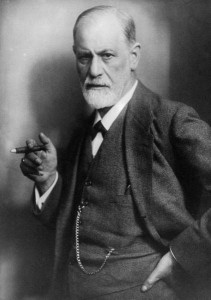
| Born: May 6, 1856 in Freiberg in Mähren, Moravia, Austrian Empire |
| Died: Sep 23, 1939 (at age 83) in London, England |
| Nationality: Austrian |
| Fields: Psychotherapy |
| Famous For: Psychoanalysis |
| Awards: Goethe Prize (1930), Foreign Member of the Royal Society (London) |
Sigmund Freud was very famous Austrian neurologist who later became known as founding father of the psychoanalysis. He is one amongst the most famous figures and controversial thinkers of the 20th century.
Early Years
Freud was born on May 6, 1856, in an Austrian town called Freiberg (now Czech Republic). At an early age of 4, his family moved to Vienna, which is the town where he lived and worked for most of his life. At age 17, he joined University of Vienna. At first he wanted to study law, but he later changed his mind and joined the medical faculty.
Here his studies included philosophy. In 1881, Freud received his medical degree. He then carried out some research on cerebral palsy, aphasia, and microscopic neuroanatomy. In 1882, Sigmund Freud married Martha Bernays. The couple had six children. In 1885, he became a lecturer and later a professor in 1902.
Early Career
Early in his career, Sigmund was influenced by the work of his good friend, Josef Breur. Josef had previously discovered that when he encouraged a hysterical patient to talk about the earliest occurrences of the symptoms, the symptoms at times slowly abated.
With the help of Josef, Sigmund posited that neuroses had their origins in very traumatic experiences that took place in the patient’s past. Sigmund believed that the original occurrences had been long forgotten and hidden from consciousness.
Freud’s treatment was to empower his patients to remember the experience and then bring it to consciousness. In doing this, the patient is able to confront the experience both emotionally and intellectually. Sigmund believed a person could then discharge it and heal oneself the neurotic symptoms. Breuer and Freud both published their theories and findings in Studies in Hysteria in 1895.
Freud’s Publications
After working together for while, Josef ended his relationship with Freud. Josef felt that Freud was placing too much emphasis on the sexual origins of patient’s neuroses and was not willing to consider any other opinion. Freud continued to refine his own argument and in 1900, he published The Interpretation of Dreams.
In 1901, he published Psychopathology of Everyday Life and later, in 1905, he published Three Essays on the Theory of Sexuality. In 1909, Freud was invited to give lectures in the U.S. After his visits to the U.S. and his 1916 publication, Five Lectures on Psycho-Analysis, his fame rose very fast.
Contributions to Psychology
Freud’s major contributions to psychology were very influential. Today, his ideas have become interwoven into the fabric of our culture with terms like ‘repression,’ ‘Freudian slip,’ and ‘denial’ being used in everyday language. His theories covered topics like cocaine, dreams, seduction theory, life and death drives, religion, psycho-sexual development, the unconscious, femininity and female sexuality, the id, ego and super ego.
Later Life and Death
In February of 1923, Sigmund detected leukoplakia, a growth associated with heavy smoking. At first, he kept this as a secret. But in April of that year, he told his friend about it. This growth was later found to be cancerous. By mid-September of 1939, Freud had developed cancer of the jaw. This cancer was very painful. On September 23, 1939, Sigmund died. His body was cremated three days after his death.